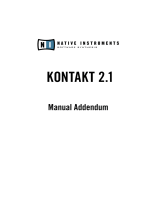
Memory Upgrades and Other Options
Program RAM vs. Sample RAM
8-1
Chapter 8
Memory Upgrades and Other Options
Program RAM vs. Sample RAM
If you’re creating a lot of your own programs, and using samples loaded from disk, there are a
few things you should be aware of to avoid perplexity. First of all, there’s an important
distinction between what we call Sample RAM and what we call Program RAM. Sample RAM
refers to any SIMMs you may have had installed in your K2500. This RAM is reserved
exclusively for sample storage; nothing else is stored there. Sample RAM is volatile; that is,
when you power down your K2500, the data stored there will “evaporate” almost immediately.
That’s why you have to load RAM samples every time you power up.
The amount of sample RAM in your K2500 is indicated in the center of the top line of the Disk
mode page. If the center of the display’s top line is blank when you’re on this page, it means
that there is no sample RAM installed in your K2500 (or that the K2500 isn’t recognizing it, in
which case you should see your dealer or service center).
Program RAM is where all the other RAM objects you create (programs, setups, QA banks,
songs, keymaps, etc.) are stored. The K2500 comes from the factory with approximately 240K of
available Program RAM. The amount of free Program RAM is indicated at the right side of the
top line of the display in Song mode and Disk mode. You can add a Program RAM (P/RAM)
option to increase your total available Program RAM to about 1250K. Ask your dealer.
Program RAM is battery-backed, so anything that’s stored there will be preserved even when
you power down (as long as your batteries have enough juice). Fresh alkaline batteries will last
up to two years, so you’ll have very few worries about losing your RAM program information.
Nonetheless, we recommend that you back up your programs, songs, etc. by saving them to
disk. This offers insurance in case the RAM becomes corrupted. This is unlikely, but still a
possibility.
If you create a program that uses a disk-loaded sample, the program information (number of
layers, keymap assignment, output group, algorithm, etc.) is stored in Program RAM. All RAM
samples associated with the program are stored in Sample RAM. This means that when you
power down, the RAM samples associated with your programs will disappear. The program
information, however, will remain in Program RAM indefinitely. When you power up again,
your RAM programs will still appear in the display as you scroll through the program list, but
they won’t play if they use RAM samples, because the RAM samples are lost when you power
down.
Viewing RAM Objects
If you’re a heavy Disk mode user, you’ll often be faced with the decision to overwrite, merge, or
append objects when you load files from disk. If you’re loading into a memory bank that’s
nearly full, this can be a tricky call, because if you decide to merge or append, there may not be
enough open slots in the memory bank to accommodate the objects you load. In this case, the
extra objects will be loaded into the next-higher memory bank.
Things get even trickier if you save dependent objects when you save to disk. (A dependent
object is any object that’s associated with another object stored in a different memory bank—for
example, a RAM sample with ID 301 that’s used in a program with ID 200. See the discussion of
dependent objects in Chapter 13 in the
Performance Guide
.) If you load a file that contains a
number of dependent objects, some of them may be loaded into a higher memory bank than

Memory Upgrades and Other Options
Choosing SIMMs for Sample RAM
8-2
the one you specified in the Bank dialog before you loaded the file. A quick way to see where
the objects you loaded ended up is to use the “Objects” Utility function in Master mode.
Select Master mode and press the
Utility
soft button. Press the
Objects
soft button, and a list of
RAM objects will appear. Use the Alpha Wheel to scroll through the list of objects. You’ll see the
type, ID, name, and size (in bytes) of each object.
Choosing SIMMs for Sample RAM
Single In-Line Memory Modules, commonly referred to by the acronym "SIMM", are the small
memory cards that the K2500 uses for Sample RAM. You can add up to eight SIMMs to your
K2500, and since they range in available size up to 16 Megabytes, that means you can add up to
128 Megabytes of Sample RAM to your machine.
The K2500 will accept 30-pin non-composite SIMMs, in sizes of 1 Megabyte, 4 Megabytes, and
16 Megabytes, in either 8-bit or 9-bit configurations. The SIMMs must have an access time of 80
nanoseconds (ns) or faster. The maximum height and width of a SIMM for the K2500 is 30mm x
90mm (approximately 1.2 inches x 3.5 inches). Below is a list of some SIMMs that will work
with your K2500:
Hitachi HB56A48A; 4Mx8
Hitachi HB56A49A; 4Mx9
TI TM124EU9B, TM124EU9C; 1Mx9
TI TM497EAD9B, TM4100EAD9; 4Mx9
TI TM4100GAD8, TM497GAD8A; 4Mx8
TI TM16100GBD8;16Mx8
TI TM16100EBD9;16Mx9
NEC MC-421000A8B; 1Mx8
NEC MC-424100A8B; 4Mx8
NEC MC-421000A9B; 1Mx9
NEC MC-424100A9B; 4Mx9
Tosh THM81000AS, Tosh THM81000BS, Tosh THM81070AS; 1Mx8
Tosh THM91000AS, Tosh THM91000BS, Tosh THM91070AS; 1Mx9
SIMMs are always installed in adjacent pairs, and must be installed by an authorized Kurzweil
facility.
CAUTION:
You must not use composite SIMMs in your K2500. A composite SIMM is one that uses a
PAL or other additional circuitry to make multiple DRAM chips act like bigger chips. Non-composite
SIMMs (the kind you may use in your K2500) have no chips other than DRAM memory chips soldered
to the board. SIMMs with PALs, buffers, or other logic components will not work in your K2500, and
must not be used.
Using Headphones with the K2500
A good pair of headphones can be indispensable when you want to play but need to keep the
volume down. You’ll get optimum performance from headphones with at least 50 ohms
impedance, but anything over 8 ohms is adequate. Headphone volume decreases as the
impedance decreases.
-
 1
1
-
 2
2
Ask a question and I''ll find the answer in the document
Finding information in a document is now easier with AI
Related papers
Other documents
-
ENSONIQ ASR-88 User manual
-
Actron CP9580AL Performance Charts
-
 ZEOS PANTERA User manual
ZEOS PANTERA User manual
-
 Native Instruments Kontakt 2.1 User manual
Native Instruments Kontakt 2.1 User manual
-
Actron CP9580AL Quick Chart
-
Toshiba AR-B1375 User manual
-
Innova 3150b Owner's manual
-
Korg TRITON Le Easy Start Guide
-
Micronics M6Mi Pentium Pro User manual
-
Husqvarna k2500 User manual



